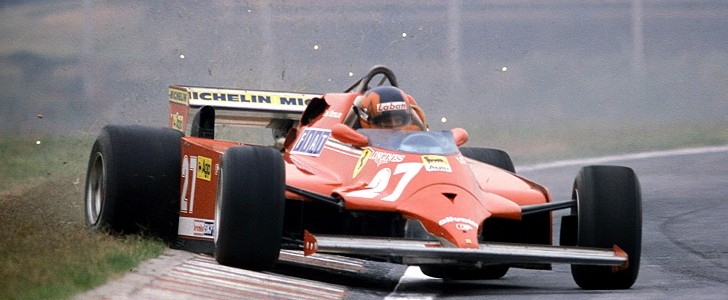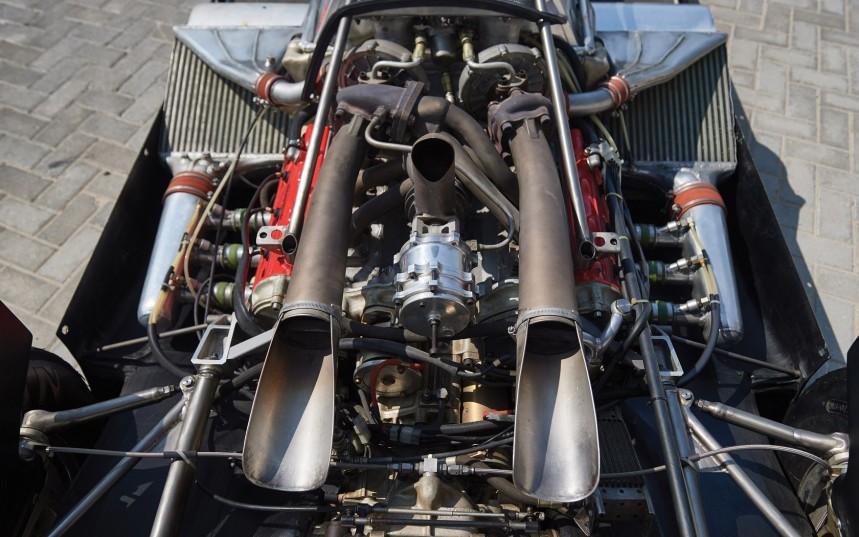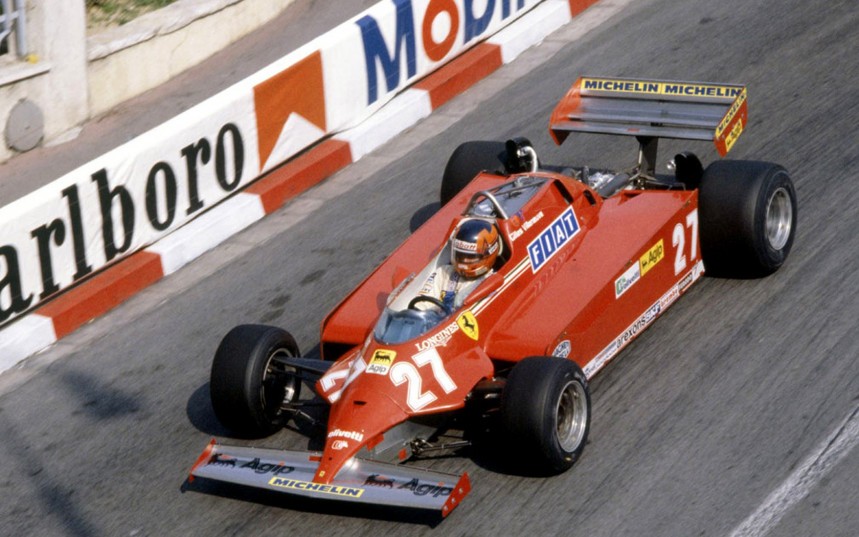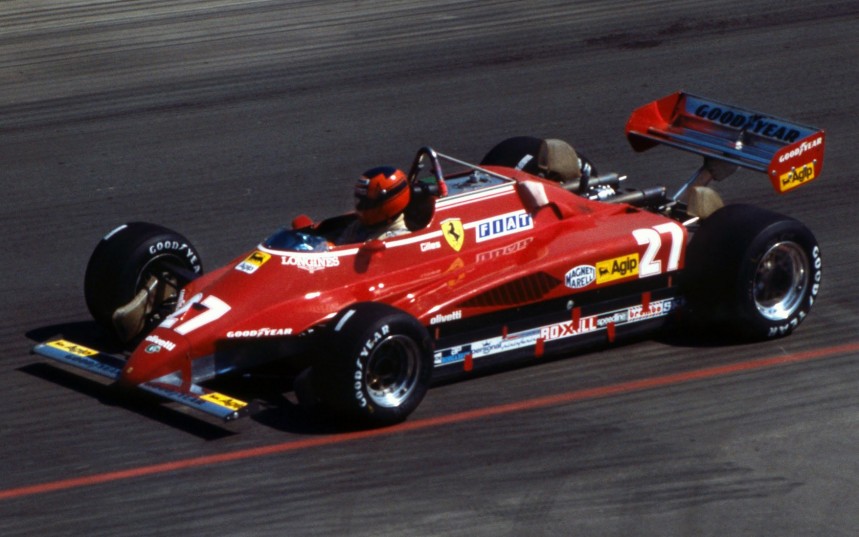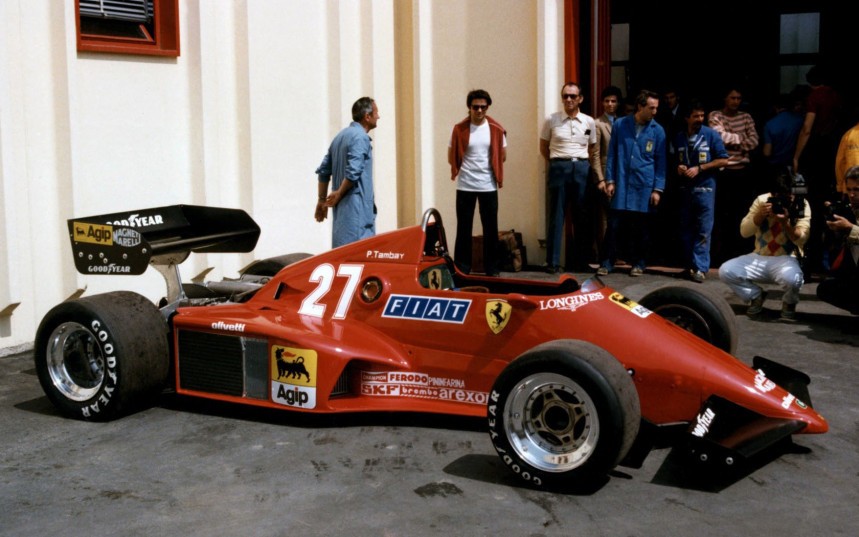Built to replace the illustrious 312T, the 126C was Ferrari’s first turbocharged Formula One car. It never managed to reach the same level of success as its predecessor, but it did bring a couple of constructor’s titles to the Scuderia in its four years of service, thanks to one of the most powerful engines of the early 1980s.
After a catastrophic 1980 campaign that saw the Italian team finish 10th in the final constructors’ standings without winning a single race, it was clear to everybody that the successful 312T, which was in use since 1975, became completely obsolete.
Though ultra-reliable, its wide flat-12 boxer was no longer useful in the ‘ground effect’ era, obscuring the airflow necessary to generate enough downforce to remain competitive.
A year earlier, when the team obliterated the competition and won both drivers’ and constructors’ titles, Enzo Ferrari predicted the downfall of the current engine and hired Nicola Materazzi in December 1979 to develop a new powerplant.
He was chosen for his invaluable experience with forced induction that he gained working on the legendary Lancia Stratos Gr 5 cars, as The Boss was convinced that turbocharged units were the future of the sport, despite his personal loathing for them.
Materazzi and his engineers developed a smaller and narrower V6 during the first part of 1980 and initially equipped it with a Comprex pressure wave supercharger.
The system was praised by drivers for generating extra power eliminating the notorious lag of the turbocharger, but since it was too tall to properly fit in the car without disturbing aerodynamics, the team eventually opted for twin KKK turbochargers.
The final 1.5-liter (91.3 cu in) longitudinally-mounted 120-degree V6 produced around 600 bhp (447 kW; 608 PS) in qualifying trim and was detuned to 550 bhp (410 kW; 558 PS) in race trim.
Initially, it was fitted to an almost identical chassis used on the 312T5, along with a transverse six-speed gearbox, giving birth to the first version of the new car, which was given the name 126CK.
First tested during the 1980 Italian Grand Prix held at Imola, it was a lot faster than the struggling 312T5, but its handling was not what the team expected, with Gilles Villeneuve calling the car "a big red Cadillac".
Although scoring back-to-back victories in Monaco and Spain in 1981, the 126CK’s problematic handling led to another disappointing season for Scuderia Ferrari, which finished fifth in the constructors’ standings.
The arrival of British engineer and aerodynamics expert Harvey Postlethwaite radically changed the course of the team. He immediately realized that, although the engine was powerful, the chassis “had a quarter of the downforce that the Williams or Brabham had that year".
His invaluable know-how led to a complete overhaul of the car before the start of the 1982 season. The engine was updated to minimize turbo lag, while the chassis and bodywork were completely redesigned.
The old steel tube frame inherited from the 312T was replaced by a state-of-the-art carbon fiber monocoque chassis with honeycomb aluminum panels.
Thanks to these updates, the 126C2 was smaller, quicker, and handled far better than the previous version. Unfortunately, the season was marked by the tragic loss of Gilles Villeneuve during qualifying for the Belgian Grand Prix.
Ferrari’s other driver, Didier Pironi, was nearly killed in a similar accident in Germany, putting an end to his driving career. Despite this, the Scuderia managed to secure a Constructors' Championship, thanks to the superiority of the much-improved 126C2.
For the 1983 season, several rule changes led to a revised “B” spec car. Postlethwaite designed an oversized but extremely effective rear wing, while the engineers further enhanced the engine, which now produced around 800 bhp (597 kW; 811 PS) in qualifying and over 650 bhp for racing.
The car would be raced for the first half of the season by two new French drivers, Patrick Tambay and René Arnoux, before being replaced by the 126C3, a car that featured minor aerodynamical improvements.
The Frenchmen managed to score four victories and were both in contention for the drivers’ title, but reliability issues in the latter part of the season cost them. However, the two 126C variations used that year were good enough to earn Ferrari a second consecutive constructors’ title.
In the last season for the 126C series, the improved 850 bhp (634 kW; 862 PS) version called 126C4 struggled to compete against the legendary McLaren MP4/2, which would dominate the season. Ferrari only managed to win one race that year and ultimately finished second in the constructors’ standings.
Although it did not exceed its predecessor, the 126C was one of the better cars in Formula one, and its twin-turbo V6 was one of the most powerful powerplants in the competition from 1981 to 1984, which is not a bad feat for Ferrari’s first turbocharged F1 engine.
Though ultra-reliable, its wide flat-12 boxer was no longer useful in the ‘ground effect’ era, obscuring the airflow necessary to generate enough downforce to remain competitive.
A year earlier, when the team obliterated the competition and won both drivers’ and constructors’ titles, Enzo Ferrari predicted the downfall of the current engine and hired Nicola Materazzi in December 1979 to develop a new powerplant.
He was chosen for his invaluable experience with forced induction that he gained working on the legendary Lancia Stratos Gr 5 cars, as The Boss was convinced that turbocharged units were the future of the sport, despite his personal loathing for them.
Materazzi and his engineers developed a smaller and narrower V6 during the first part of 1980 and initially equipped it with a Comprex pressure wave supercharger.
The system was praised by drivers for generating extra power eliminating the notorious lag of the turbocharger, but since it was too tall to properly fit in the car without disturbing aerodynamics, the team eventually opted for twin KKK turbochargers.
Initially, it was fitted to an almost identical chassis used on the 312T5, along with a transverse six-speed gearbox, giving birth to the first version of the new car, which was given the name 126CK.
First tested during the 1980 Italian Grand Prix held at Imola, it was a lot faster than the struggling 312T5, but its handling was not what the team expected, with Gilles Villeneuve calling the car "a big red Cadillac".
The arrival of British engineer and aerodynamics expert Harvey Postlethwaite radically changed the course of the team. He immediately realized that, although the engine was powerful, the chassis “had a quarter of the downforce that the Williams or Brabham had that year".
His invaluable know-how led to a complete overhaul of the car before the start of the 1982 season. The engine was updated to minimize turbo lag, while the chassis and bodywork were completely redesigned.
The old steel tube frame inherited from the 312T was replaced by a state-of-the-art carbon fiber monocoque chassis with honeycomb aluminum panels.
Ferrari’s other driver, Didier Pironi, was nearly killed in a similar accident in Germany, putting an end to his driving career. Despite this, the Scuderia managed to secure a Constructors' Championship, thanks to the superiority of the much-improved 126C2.
For the 1983 season, several rule changes led to a revised “B” spec car. Postlethwaite designed an oversized but extremely effective rear wing, while the engineers further enhanced the engine, which now produced around 800 bhp (597 kW; 811 PS) in qualifying and over 650 bhp for racing.
The car would be raced for the first half of the season by two new French drivers, Patrick Tambay and René Arnoux, before being replaced by the 126C3, a car that featured minor aerodynamical improvements.
In the last season for the 126C series, the improved 850 bhp (634 kW; 862 PS) version called 126C4 struggled to compete against the legendary McLaren MP4/2, which would dominate the season. Ferrari only managed to win one race that year and ultimately finished second in the constructors’ standings.
Although it did not exceed its predecessor, the 126C was one of the better cars in Formula one, and its twin-turbo V6 was one of the most powerful powerplants in the competition from 1981 to 1984, which is not a bad feat for Ferrari’s first turbocharged F1 engine.
